FNR Field Reports: Sophia DeMoss Offers Week 1 Update from Sweden Study Abroad Program
Throughout the 2024 Sustainable Natural Resources study abroad course in Sweden, FNR students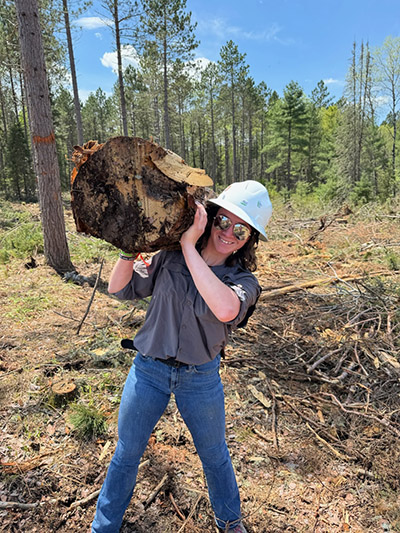 will check in to provide weekly updates on the trip highlights. Forestry major Sophia DeMoss takes the reins on Week 1,sharing about stops in Uppsala and Skinnskatteberg.
will check in to provide weekly updates on the trip highlights. Forestry major Sophia DeMoss takes the reins on Week 1,sharing about stops in Uppsala and Skinnskatteberg.
During the four-week Sustainable Natural Resources study abroad course students will examine natural resources broadly defined, including forestry, fisheries, wildlife, agriculture, mining, outdoor recreation, and urban sustainability. They will define, discover, and document examples where sustainability of resource use matters. The course explores the effect of terrain, climate, vegetation, faunal assemblages, social structures and technologies on natural resource use. FNR 46000 is a collaboration of Purdue University, North Carolina State University, and the Swedish University of Agricultural Sciences. American and Swedish students work together to research issues in resource management.
The course is co-taught by FNR's Drs. Tomas Hook and Doug Jacobs as well as other instructors from NC State and SLU.
Monday July 1, 2024
Today we visited the USL university in Uppsala in the morning. We got to learn about a few sustainable practices in Sweden, general information about the forests, as well as common causes of death or disease in trees. We heard from some professors and graduate students. The hosts provided a wonderful lunch of fresh fruits, vegetables, meats, and bread. They also had a cheese pie that I wasn’t particularly a fan of. We went on a hike through one of the Linnaeus trails in Uppsala. This trail system follows the paths that Carl Linnaeus took in his studies. I used my plant ID app a ton to learn about new trees that don’t grow in America. One thing that I thought was really amazing is seeing some native plants in Sweden that are invasive back home. After class finished up, I went with a group to the Botanical gardens in Uppsala. These gardens were very pretty; I will want to go back and explore the gardens more. I again used my app to learn about the plants they had there. When I was leaving, I saw a few people playing a French game similar to curling called pétanque.
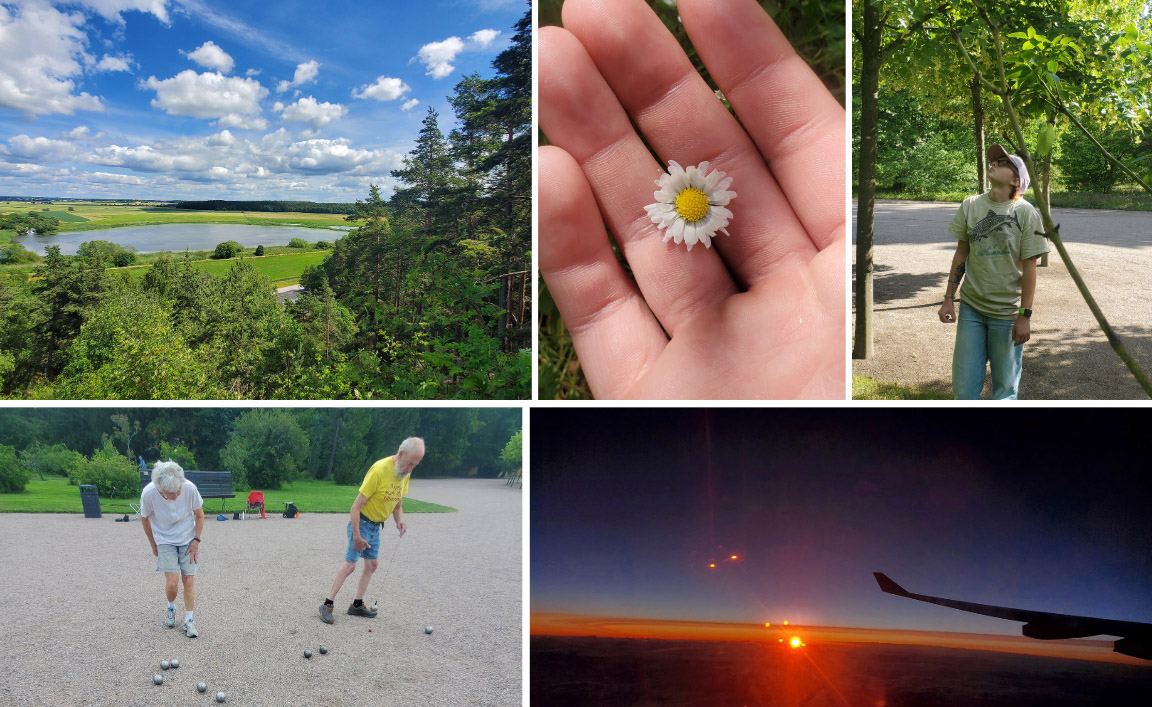 A collage of images from Day 1 of the Sweden Study Abroad trip: Top row (left to right) - The view over what used to be covered by the Baltic Sea; part of the Linnaeus trail; Common Daisy; Elizabeth Nojd at the botanical garden. Row 2 (Left to Right): Swedish people playing pétanque; A picture taken from the window of the plane at sunset, still over Canada
A collage of images from Day 1 of the Sweden Study Abroad trip: Top row (left to right) - The view over what used to be covered by the Baltic Sea; part of the Linnaeus trail; Common Daisy; Elizabeth Nojd at the botanical garden. Row 2 (Left to Right): Swedish people playing pétanque; A picture taken from the window of the plane at sunset, still over Canada Tuesday, July 2, 2024
Today we took a train to Stockholm and spent the entire day in the city. Learning a little bit of the train/metro/bus system was interesting to me; I have never been in a city big enough for these. Our first stop for the class was the Royal National City Park. The park used to be the Kings hunting ground. The area is unique because it was only a short walk from Stockholm, a very large city, and it felt like we were walking in the wilderness. We learned about more diseases and bugs that effected the local trees. The best part of the park was the old oak trees. They were about 700 years old and the DBH was usually between 50-70 inches. For lunch a group of us went to a small restaurant called Gårds Kök. A lot of the restaurants in Stockholm had open fronts for nice weather, which is really cool.
After lunch my group had to run through the city to make it to our next activity on time as our bus was late to the stop. We ran to the Vasa Museum for a private tour from the curator. The Vasa was a Swedish war ship that is famous for sinking two minutes into its maiden voyage. The speaker was very knowledgeable about the whole topic. My favorite parts where the messages all the art sent to enemy ships and when our host talked about reconstruction of skeletons. It was especially cool to learn all the forensics they use when reconstructing these skeletons and the information they can store. After the museum, we got the chance to spend the evening in Stockholm. I walked around the older part of the city, which has become a very touristy location with little shops and restaurants.
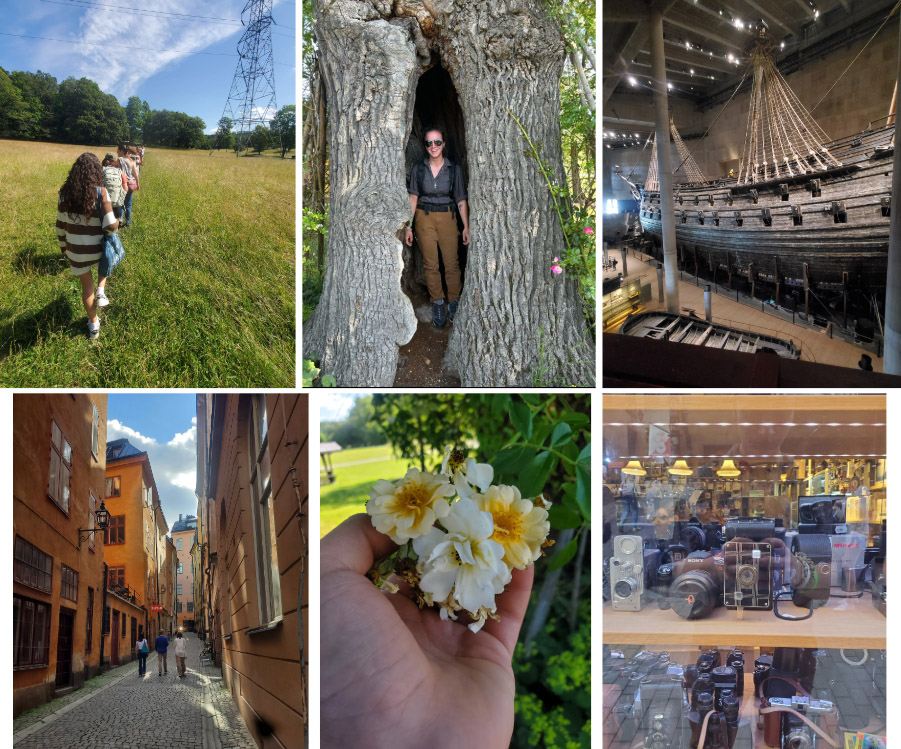 A collage of photos from Day 2 of the Sweden Study Abroad Trip: Top Row (Left to Right) - Walking in the Royal National City Park; standing in a hollow oak tree in the Royal National City Park (photo credit - Elizabeth Nojd); The Vasa. Row 2 (Left to Right): Old Town in Stockholm; Wild roses; A shop window full of cameras.
A collage of photos from Day 2 of the Sweden Study Abroad Trip: Top Row (Left to Right) - Walking in the Royal National City Park; standing in a hollow oak tree in the Royal National City Park (photo credit - Elizabeth Nojd); The Vasa. Row 2 (Left to Right): Old Town in Stockholm; Wild roses; A shop window full of cameras. Wednesday July 3, 2024
This morning, we toured a power plant here in Uppsala, venturing more towards the industrial side of the city. One amazing thing about Uppsala is how much it doesn’t feel like a city, not like back in the states. Everything here is calm and slow paced unlike back home. Touring the power plant was a fantastic experience. We learned about the sustainable practices the plant uses to keep the city going. Sweden believes that when cutting wood, every part can be used. The plant uses mostly biofuels to power the city.
After the tour we got to do a scavenger hunt made by our instructors to get to know the city better. I got to go to the Uppsala Cathedral first to see Carl Linnaeus’ tomb. This was one of my favorite locations. The cathedral is such a landmark of the city and a wonderful sight inside and out. I also went to the city graveyard to find the grave of Dag Hammarkskjöld. I spent all afternoon and well into the evening wondering around the north side of the city into neighborhoods and through public parks. The graveyard was one of my favorite sites. The graves were very well taken care of and clean, with very few of the head stones crumbling or in shambles.
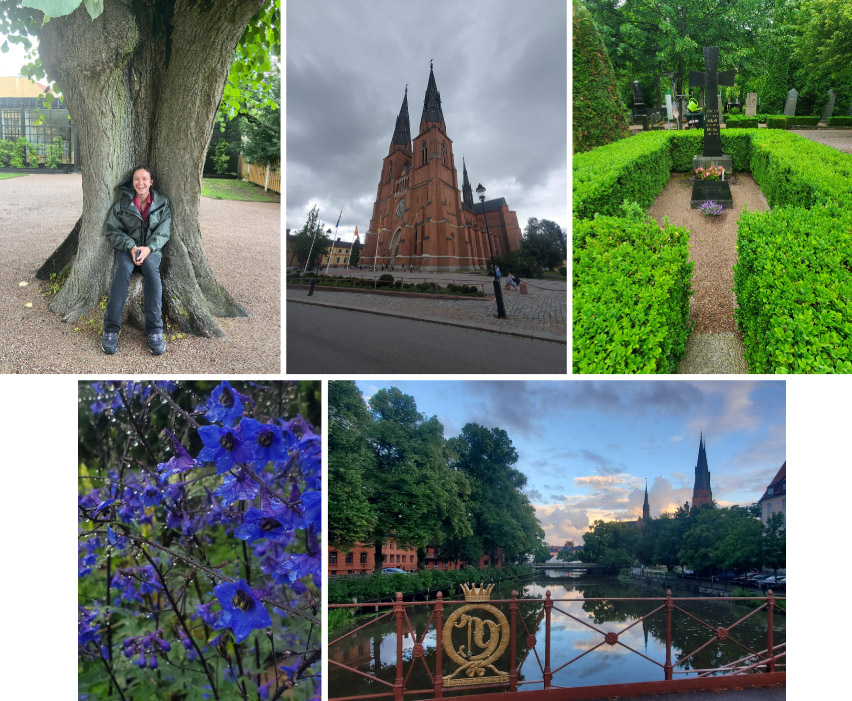 A collage of images from Day 3 in Sweden: Top Row (Left to Right) - Sophia sits on a knotted tree in the Linnaeus Garden (photo credit - Elizabeth Nojd); Uppsala Cathedral; A grave in the Uppsala graveyard. Row 2 (Left to Right): Candle Larkspur in Linnaeus’ gardens; Sunset over the River Fyris in Uppsala.
A collage of images from Day 3 in Sweden: Top Row (Left to Right) - Sophia sits on a knotted tree in the Linnaeus Garden (photo credit - Elizabeth Nojd); Uppsala Cathedral; A grave in the Uppsala graveyard. Row 2 (Left to Right): Candle Larkspur in Linnaeus’ gardens; Sunset over the River Fyris in Uppsala. Thursday July 4, 2024
It has been different to not be celebrating Independence Day like I would back home. We did have a free day today, which I took full advantage of. In the morning before breakfast me and some other Purdue FNR students went bird watching along another Linnaeus trail. We saw a lot of cool birds that the wildlife students could name much better than myself. We also saw a beaver in one of the ponds we saw. Breakfast at the hotel consisted of fresh breads, croissants, meats, medium boiled eggs, and fresh fruits. They also had some more adventurous foods I wasn’t quite ready to try; one of which included caviar.
After breakfast me and the other two girls in the Purdue FNR program ventured to the Biologiskt Museum and watched/learned about aquatic snails for two hours. After that we ventured back into Stockholm for more bird watching in the Royal National City Park. We saw a green woodpecker and a sandpiper along with several other birds. One of the best moments of the day was when we saw and oak tree well over 80 inches in diameter. It was so big I was able to climb it as though it were a bouldering wall. This was easily the largest tree I’ve ever seen. Dr. Jacobs told me later that there would be even bigger trees as we head south. This was a bad trip to not bring my forester’s tape.
For dinner we went to the oldest restaurant in Sweden called Den Gyldene Freden. It was established in 1722 and has stayed there all this time. I had traditional Swedish meatballs with some of the best mashed potatoes I’d ever eaten. I could see why they were able to stay open for all that time. It was a great day for fun, adventure and wonder.
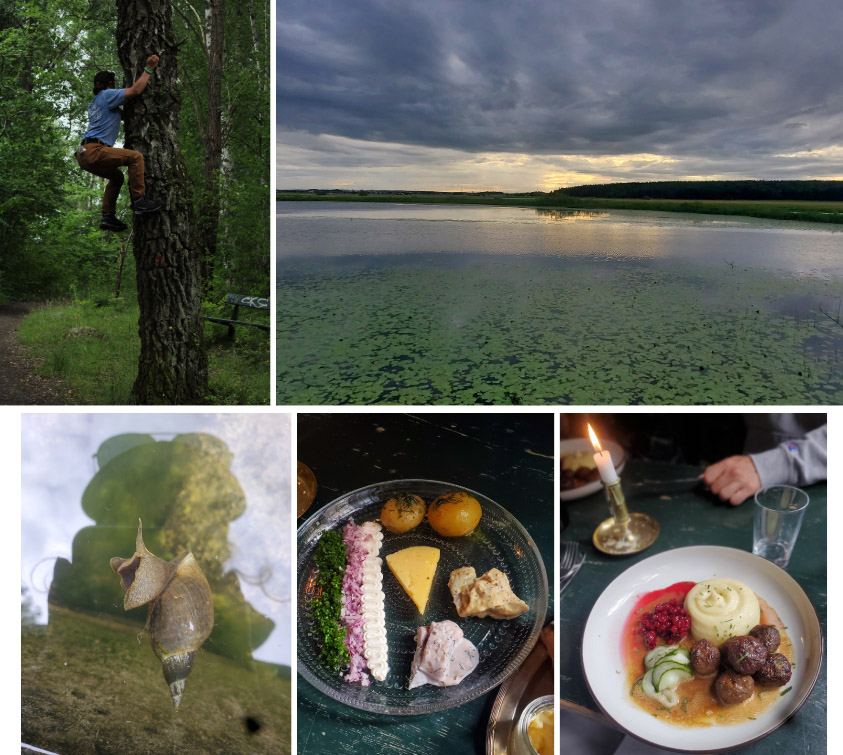 A collage of images from Day 4 of the Sweden Study Abroad trip. Top row (Left to Right): Sophia climbing a birch tree in the Royal National City Park (photo credit - Elizabeth Nojd); The group's morning bird watching destination. Row 2 (Left to Right): A snail Sophia sat and watched for two hours; appetizer from Den Gyldene Freden; meal from Den Gyldene Freden.
A collage of images from Day 4 of the Sweden Study Abroad trip. Top row (Left to Right): Sophia climbing a birch tree in the Royal National City Park (photo credit - Elizabeth Nojd); The group's morning bird watching destination. Row 2 (Left to Right): A snail Sophia sat and watched for two hours; appetizer from Den Gyldene Freden; meal from Den Gyldene Freden. Friday July 5, 2024
Today we left Uppsala to head to Skinnskatteburg; a much smaller town with a little university in it. Other than the move it was an uneventful day. We toured the campus and I was able to have a small fire for a little while in the evening.
 A collage of images from Day 5 of the Sweden Study Abroad trip. Left to right: Elizabeth Nojd and Sophia having a fire in Skinnskatteberg; Elizabeth sitting in ferns; Breakfast provided by the hotel in Uppsala.
A collage of images from Day 5 of the Sweden Study Abroad trip. Left to right: Elizabeth Nojd and Sophia having a fire in Skinnskatteberg; Elizabeth sitting in ferns; Breakfast provided by the hotel in Uppsala. Saturday July 6, 2024
Today we got to tour privately owned forests learning about some of the management practices and the laws Sweden has in place to protect the environment. The company who owned the land is called Snefringe which is actually locally owned by the farmers who really own the land. They have a shareholder system that allows the farmers each to own the forest around their lands. We learned about the conservation areas they are required to keep, where the wildlife can be left undisturbed. In the afternoon we had the opportunity to plant pine and spruce seedlings in a previously clear-cut area. This is something I have really considered getting into as a career, so I really enjoyed getting this opportunity. I want to manage a tree nursery after I settle out of my season work after college. We also experienced a Swedish fika; this is a custom of sitting for an afternoon coffee or tea with some sort of sweet bread, usually a cinnamon bun. We went to a little bed and breakfast spot called Baggå Skola.
 A collage of images from Day 6 of the Sweden Study Abroad trip. Top row (Left to Right): Graveyard church in Skinnskatteburg; Elizabeth Nojd with a toad. Row 2(Left to Right): Foraged wild blueberries; A wall in Baggå Skola
A collage of images from Day 6 of the Sweden Study Abroad trip. Top row (Left to Right): Graveyard church in Skinnskatteburg; Elizabeth Nojd with a toad. Row 2(Left to Right): Foraged wild blueberries; A wall in Baggå Skola Sunday July 7, 2024
Today we visited the Sala Silver Mine in the morning. On the way there we some of us students had to get out of the bus to move a downed spruce out of the road. At the mine we learned about the methods used for mining back in the 1500s to 1900s and how those changed over time. I enjoyed walking through the mines and hearing about the practices they used to retrieve resources such as silver, lead, and zinc. There were also period games, food, and gifts to buy from little shops. Several of us played tug of war and walked on stilts. After lunch, we went to a strawberry farm and picked strawberries and saw several farm animals. After class was over, a few of us took the bus with Dr. Jacobs and went swimming in Lake Vättern. The water was very cold, but getting out into the wind was even colder.
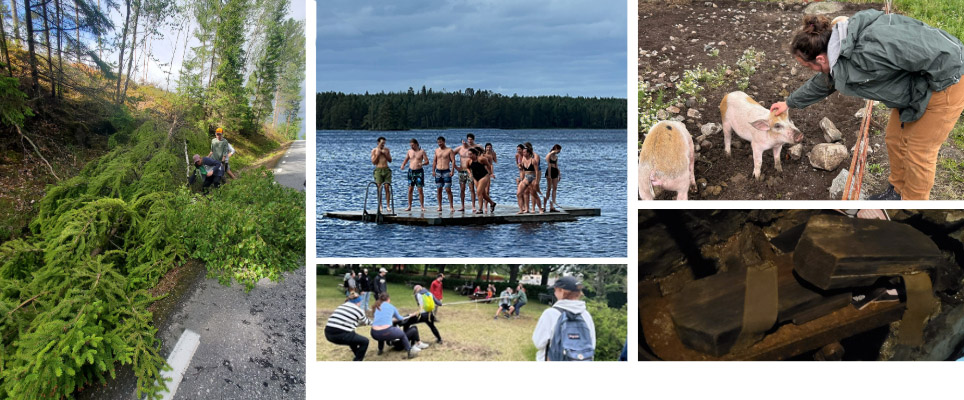 A collage of images from Day 7 of the Sweden Study Abroad trip. Top row (Left to right): Spruce the group had to move out of the road; A group of students stand on the docks after swimming in Lake Vättern (photo credit - Lauren Bosteder). ; Sophia petting a pig (photo credit - Mal Wagner). Row 2: Game of tug-of-war (photo credit - Jennifer MacLellan); Wood shoes the miners used to wear.
A collage of images from Day 7 of the Sweden Study Abroad trip. Top row (Left to right): Spruce the group had to move out of the road; A group of students stand on the docks after swimming in Lake Vättern (photo credit - Lauren Bosteder). ; Sophia petting a pig (photo credit - Mal Wagner). Row 2: Game of tug-of-war (photo credit - Jennifer MacLellan); Wood shoes the miners used to wear. 





